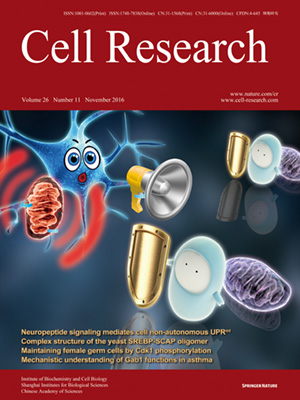
Volume 26, No 11, Nov 2016
ISSN: 1001-0602
EISSN: 1748-7838 2018
impact factor 17.848*
(Clarivate Analytics, 2019)
Volume 26 Issue 11, November 2016: 1255-1259 | Open Access
LETTERS TO THE EDITOR
The genome-wide mutational landscape of pituitary adenomas
Zhi-Jian Song1,*, Zachary J Reitman2,*, Zeng-Yi Ma3,4,*, Jian-Hua Chen1,5,*, Qi-Lin Zhang3,4,*, Xue-Fei Shou3,4,*, Chuan-Xin Huang6, Yong-Fei Wang3,4, Shi-Qi Li3,4, Ying Mao3,7,8, Liang-Fu Zhou3,4, Bao-Feng Lian9, Hai Yan10, Yong-Yong Shi1 and Yao Zhao3,4,7,8
1Bio-X Institutes, Ministry of Education Key Laboratory for the Genetics of Developmental and Neuropsychiatric Disorders, Institute of Social Cognitive and Behavioral Sciences, Shanghai Jiao Tong University, Shanghai 200030, China
2Harvard Radiation Oncology Program, Harvard Medical School, Boston, MA02115, USA
3Department of Neurosurgery, Huashan Hospital, Shanghai Medical College, Fudan University, Shanghai 200040, China
4Shanghai Pituitary Tumor Center, Shanghai 200040, China
5Shanghai Key Laboratory of Psychotic Disorders, Shanghai Mental Health Center, Shanghai Jiao Tong University School of Medicine, Shanghai 200030, China
6Shanghai Institute of Immunology & Department of Immunobiology and Microbiology, Shanghai Jiao Tong University School of Medicine, Shanghai 200025, China
7State Key Laboratory of Medical Neurobiology, Shanghai Medical College, Fudan University, Shanghai 200040, China
8Institute of Neurosurgery, Shanghai Medical College, Fudan University, Shanghai 200040, China
9Shanghai Center for Bioinformation Technology (SCBIT), Shanghai Academy of Science and Technology, Shanghai 201203, China
10Department of Pathology, The Preston Robert Tisch Brain Tumor Center, Duke University Medical Center, Durham, NC 27710, USA
Correspondence: Yong-Yong Shi, Tel: +86-21-62390050 E-mail: shiyongyong@gmail.com; Hai Yan, Tel: +1-919-668-7850 E-mail: hai.yan@duke.edu; Yao Zhao, Tel:+86-21-52888728(zhaoyaohs@vip.sina.com)
Pituitary adenomas (PAs) are one of the most common intracranial tumors, which can result in significant morbidity and can cause mortality either by exerting central pressure effects from the pituitary mass or by secreting excessive pituitary hormones1. Depending on their capability to produce hormones, PAs are classified as clinically functioning and nonfunctioning (NF). Functioning PAs include 6 subtypes, characterized by hypersecretion of prolactin (PRL), growth hormone (GH), adrenocorticotropin (ACTH), gonadotropins including follicle stimulating hormone and luteinizing hormone (GT), thyrotropin (TSH) or multiple hormones (plurihormonal), respectively. We and other group recently reported the recurrent genetic mutations in ACTH-PAs2,3. Previous studies also identified genetic alterations in GH-PAs by whole-genome and -exome sequencing4,5 and in 7 NF-PAs by exome analysis6. Due to challenges in collection and preparation of PA samples, exome-wide sequencing of other subtypes, including the PRL-, GT-, TSH-, and plurihormonal PA subtypes, has not been reported yet.
10.1038/cr.2016.114
FULL TEXT | PDF
Browse 1825


